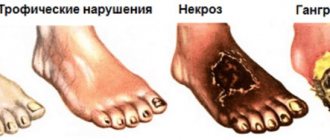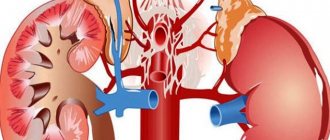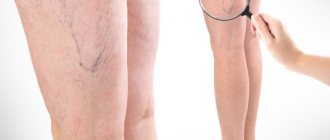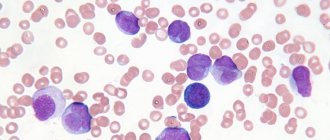Initial stage of diabetic foot
In diabetes, insulin is not produced enough, which helps glucose enter the cells of all organs. With its shortage, the concentration of glucose in the blood increases, which provokes a disruption of the blood flow system and depletes the vascular membranes and nerve fibers.
Ischemia of the bloodstream leads to poor healing of wounds, and deformation of fibers in the nervous system leads to a low sensitivity threshold.
Minor wounds or cracks on the heels can develop into trophic ulcers, which, as the pathology progresses, grow into tissue necrosis, which leads to gangrene on the affected limb.
The initial stage of the syndrome, its manifestations go unnoticed for a diabetic, due to low painful sensitivity. Poor blood supply to the legs leads to the fact that any cut or callus can turn into an ulcer and the patient does not notice it.
In the initial stage, ulcers most often affect the part of the foot that is most subject to stress during movement, and on which there are layers of hardened skin.
Under such a layer, corns and abrasions quite often form, and when infections get into them, they begin to become inflamed and fester.
The ulcers first develop under the layer of skin, but then affect the epidermis and can develop to the tendons of the leg, or affect the muscle tissue to the bones.
Such lesions threaten limb amputation.
Angiopathy
In diabetes, damage to blood vessels often occurs - angiopathy. They become covered with atherosclerotic plaques, which leads to circulatory failure in the foot. It looks a bit like rusty pipes. Very little water comes out of the tap due to rust blocking the inside of the pipes. The same thing happens when blood vessels are clogged. If the vessels in the legs become clogged or completely blocked, the skin and tissues will suffer first from poor circulation. The process of delivering oxygen and nutrients to the limb will be disrupted, which means cell death in the affected area.
- Decreased ability to fight infection
- The ability to heal wounds will decrease.
- Signs of blood vessel damage
- Pain in the lower leg when walking,
- A change in the normal color or temperature of the feet,
- Leg pain at night or while resting.
If nerve damage is combined with poor circulation, the risk doubles. You are more likely to get injured (because you don't feel pain) and the injury will lead to infection or ulceration. Healing will not occur due to poor circulation, which will inevitably lead to gangrene.
Risk factors for developing diabetes include poor diet and glucose control, poor circulation, smoking, and diabetes mellitus of more than 10 years.
Causes of diabetic foot development
Etiology of diabetic foot development:
- Low sensitivity of the legs, diabetic neuropathy,
- Blood flow in the arteries is impaired - macroangiopathy,
- Insufficient blood flow in the capillaries of the extremities, microangiopathy,
- Dry skin,
- Deformation of the feet, motor type neuropathy.
There are other causes of diabetic foot syndrome:
- Pathology hyperkeratosis, severe enlargement of the epidermis on the legs,
- Wearing uncomfortable shoes
- Cuts to the foot when the skin is treated with sharp instruments.
Decreased sensation - diabetic distal neuropathy
Impact of atherosclerosis
People with diabetes are very often susceptible to the systemic disease atherosclerosis.
The process of development of atherosclerosis in such people has its own characteristics: medium-diameter vessels and capillaries are damaged.
The ischemic stage of atherosclerosis is characterized by symptoms of diabetic foot:
- Severe pain in the foot at night,
- The pain becomes less when raising the legs in a horizontal position, or when lowering the limbs from the bed,
- Low skin temperature,
- The skin has a pale appearance with a bluish tint,
- Ulcers occur on the fingertips and lead to necrosis of tissue cells.
Most often, amputation of limbs threatens those diabetics who develop atherosclerosis.
Impaired blood flow - diabetic macroangiopathy
Flow
When the development of diabetic foot begins, diet and control of sugar levels, proper foot care, periodic examination of the feet and timely monitoring by a doctor are extremely important. In this case, complications rarely develop. In European countries where podiatry services are developed, the development of diabetic gangrene is very rare. The number of amputations due to diabetes in Europe has decreased tenfold, but in Russia diabetic gangrene is the main cause of high amputation rates.
Forms of the syndrome
Depending on the predominance of the factor in the onset and progression of diabetic foot, there are 3 diabetic foot diseases.
Neuropathic form of pathology. With this type, damage occurs to the somatic nervous system, as well as the autonomic function of nerve fibers.
Diabetic neuropathy is represented by several variants of the causes and development of pathology, but the main causes for diabetic neuropathy are:
- Low conductivity of nerve endings,
- Reduced nervous tactile sensitivity of peripheral fibers,
- Low vibration sensitivity,
- Very low sensitivity to heat.
The neuropathic form of diabetic foot manifests itself in three variants of the development of the disease:
- Development of foot ulcers
- Pathology osteoarthropathy, which forms a disorder in the Charcot joint,
- Neuropathic edema.
Ischemic form of diabetic foot. The development occurs due to atherosclerotic disorders in the membranes of the peripheral arteries, which leads to changes in the blood flow system.
The mixed form of diabetic foot is a neuroischemic form. This form is most common in diabetics. Its manifestations include symptoms of neuropathy, which affects nerve fibers, as well as ischemia of the blood flow system, when the blood circulation is disrupted.
Individual forms of diabetic foot appear quite rarely, perhaps only at the moment when the initial stage of the disease occurs.
If neuropathy exists, then it still leads to disorders of the vascular system, and also, if complications of atherosclerosis occur and ischemia of the blood flow system is developed, then a disorder occurs in nerve impulses and fibers.
The two main causes of diabetic foot syndrome are closely related to each other.
Classification
Neuropathic form - impaired sensitivity of the feet like stockings or socks, dry skin, small cracks are possible. Nerve damage is a common complication of diabetes mellitus, sensitivity disorders occur in the feet, up to its complete loss, damage to the motor nerves leads to muscle atrophy. In the neuropathic form, some patients do not feel injury, temperature, skin punctures and receive injuries that can lead to infection.
Osteopathic form - destruction of bones and joints leading to foot deformation, the formation of trophic ulcers and skin damage. Poor circulation weakens bones, and can cause the bones and joints in the foot and ankle to deteriorate. Weakness of the ligamentous apparatus leads to multiple dislocations of the bones of the foot and its deformation. Bone destruction and pathological fractures are not accompanied by pain symptoms and can occur unnoticed by the patient, up to perforation of the skin by a bone fragment. In such cases, purulent complications and wet gangrene develop unnoticed.
The ischemic form is a violation of the blood supply to the foot with the formation of trophic ulcers and dry gangrene. It develops when blood flow is blocked due to plaque blocking the arteries. Against the background of ischemia, dry necrosis of the fingers or feet is observed, easily turning into wet gangrene. The most dangerous thing with diabetes is that, in conditions of decreased sensitivity, the patient may not pay attention to the appearance of trophic ulcers and necrosis and progress his disease to diabetic phlegmon.
Diabetic phlegmon and gangrene are severe purulent destruction of the soft tissues and bones of the foot against the background of impaired blood circulation. Cellulitis can develop with preserved vascular patency, and gangrene only with blockage of the arteries of the leg. The causes of phlegmon and gangrene are different, but the result is usually the same - amputation. Only timely specialized surgical care can count on the preservation of the supporting limb. The frequent appearance of purulent and putrefactive infections is associated with impaired immunity, characteristic of patients with diabetes; in the neuropathic form, attention to injuries is reduced, and the infection easily enters the subcutaneous tissue, causing the development of diabetic phlegmon. Phlegmon is a purulent melting of soft tissue. It can be caused by various microbes, but the most dangerous are the causative agents of gas gangrene. Infection in diabetes quickly leads to intoxication and sepsis. With the development of sepsis, the patient's general condition sharply worsens, liver and kidney dysfunctions are noted, and severe pneumonia often develops. In the absence of a timely diagnosis and proper treatment, the prognosis for life is extremely unfavorable.
Also in the classification there is a mixed form of diabetic foot, which gives a variety of symptoms and requires appropriate treatment.
Signs of development of diabetic foot syndrome
The first signs of this syndrome in diabetes mellitus manifest themselves in low sensitivity:
- Initially, vibration sensitivity disappears,
- After this, a sensitive response to temperature occurs,
- Then the feeling of pain in the legs disappears,
- And as the manifestation progresses, tactile sensitivity disappears.
Other symptoms of diabetic foot include:
- Neuropathic edema in the legs,
- Decreased temperature in the lower extremities,
- Increased body temperature in the lower legs,
- Severe fatigue of the limbs,
- Heaviness in the legs when moving,
- Pain in the legs and feet when moving,
- Feeling pain in the legs during rest, especially at night,
- Tingling in the legs
- Cold feet,
- Burning in feet and toes,
- The skin is pale in color, it also shows bluishness and redness,
- Hair growth on the legs is reduced,
- Nails change, changes occur with the color of the nails and their structure,
- Long (up to 2 months) healing period for small abrasions and wounds,
- After the wound has healed, a dark bluish mark forms in its place.
The signs and distinctive features of the neuropathic form of diabetic foot and its neuroischemic form look like this:
| sign of pathology | neuropathic type of pathology | neuroischemic type of pathology |
| external signs of the condition of the legs | · the foot feels warm to the touch, | · the foot feels cold to the touch (it can be warm if there is inflammation due to infection), |
| · arteries are palpable, | rubeosis of the skin (redness), | |
| · color may be slightly pink. | hair loss occurs on the lower leg, | |
| · the sole is red or bluish. | ||
| locality of the ulcerative focus | · the area of the foot that bears the highest load during movement. | · an area on the foot or lower leg that is affected by atherosclerosis of the arteries. |
| presence of fluid in the wound | · liquid is observed at the bottom of the ulcer. | The ulcer is almost dry. |
| ulcer tissue pain | · Painful sensations are not clearly expressed. | · severe pain of the ulcer. |
| skin around the ulcer | Hyperkeratosis develops. | · skin of atrophic type, thin. |
| factors provoking pathology | type 1 diabetes mellitus, | · advanced age, |
| diabetes mellitus type 2, | · atherosclerosis, | |
| · chronic alcoholism, | · cardiac ischemia, | |
| · younger age. | post-infarction state, | |
| condition after an ischemic type of stroke, | ||
| · nicotine addiction. |
Swelling
Diabetic foot pathology most often begins with swelling in the extremities, therefore pronounced neuropathic edema in the lower leg, in the joint and in the foot is one of the main symptoms of diabetic foot syndrome.
Neuropathic swelling must be differentiated from the following pathologies:
- Excess fluid in the body,
- Kidney diseases, nephropathy,
- Phlebeurysm,
- Thrombosis of blood vessels,
- Poor outflow of venous blood from the extremities,
- Diseases of the heart organ,
- Liver pathologies.
Swelling on the lower extremities looks the same, but has a different etiology, and different methods are required in its treatment.
The causes of swelling in the legs during diabetes are not yet fully understood, but there are factors that provoke the accumulation of a large volume of fluid in the body:
- Disturbances in the autonomic and nervous system,
- Formation of a large number of shunts in the arteries and veins of the bloodstream system,
- There is a change in blood pressure in the vessels that are responsible for microcirculation in the periphery.
Swelling of the foot
Photo of what a diabetic foot looks like
The essence of the diabetic foot and its ICD-10 code
In endocrinology, the disease is considered as a complex of anatomical and functional changes that occur against the background of osteoarthropathy, neurotrophic disorders, macro- and microangiopathy. This entails the development of purulent-necrotic reactions, increasing the risk of injury to bone and soft structures. In advanced cases, SDS is accompanied by gangrene, which often spreads not only to the feet, but also to the legs. In such a situation, patients are indicated for amputation of the end part of the lower extremities.
Diabetic foot is a general term that combines several complications of decompensated diabetes. If they develop, pathological changes in the foot are observed, accompanied by damage to the osteoarticular and muscular-ligamentous formations. Necrotic processes manifest themselves as a result of dysfunction of peripheral vessels, skin, nerves, joints and bones.
In the International Classification of Diseases (ICD-10), endocrine pathology is classified as E10-E14 “Diabetes mellitus”. It is assigned the code E10.5 or E11.5, which depends on the etiology and form of the disease.
Which doctor should I contact?
All people who experience disruptions in the functioning of the endocrine system and disruptions in the functionality of endocrine organs are registered with an endocrinologist.
Diabetes mellitus is a consequence of improper functioning of the endocrine system. Diabetics, with all deviations and disruptions in the body, come with complaints to the attending doctor.
After a medical examination and the diagnosis prescribed by him, the endocrinologist recommends which doctor requires medical consultation.
If, during an examination of the patient, the endocrinologist reveals abnormalities in the skin of the feet, he refers the diabetic to a specialized specialist in diabetic pillars, a podiatrist.
If it is necessary to carry out surgical treatment of the vessels of the legs, then the podiatrist will refer you to an angiologist for examination; in order to make specialized individual insoles for the patient, a consultation with an angiosurgeon is necessary.
When making orthopedic shoes for a diabetic, one cannot do without the recommendations and prescriptions of an orthopedic doctor.
Complications
The extreme and most dangerous stage of DFS is the development of gangrene of the foot. Diabetic foot is the leading cause of non-traumatic amputation in peacetime. Every year in Russia 70,000 amputations are performed for diabetic gangrene.
Diabetic gangrene often occurs with an associated anaerobic infection. With this outcome, the damaged tissues die, and the blood and healthy tissues become infected. The disease develops very quickly, often leading to death.
Trophic ulcers are another complication, most often found on the sole or big toe. They can also form on the sides of the foot from poorly fitting shoes. If left untreated, they can lead to serious infections. The classification of complications of diabetes includes trophic changes in the skin of the foot.
What is Charcot's joint disease?
Pathologies that lead to diabetic osteoarthritis:
- Bone cell disease osteoporosis,
- Pathology hyperostosis,
- Osteolysis disease.
With prolonged progression, these pathologies lead to deformation of the foot and the development of a disease called Charcot's joint.
Quite often, the hands and ankle joints are affected by pathology of the Charcot joint, which often threatens fractures, and with low sensitivity of the limbs, a diabetic may not feel that a fracture has occurred.
Charcot's joint, which has formed, can be treated without surgery, but it is necessary to remove the load from the affected limb as much as possible until the joint is completely restored.
A patient with Charcot's joint must be provided with bed rest.
After the joint has been restored, the patient is recommended to wear orthopedic shoes made to individual measurements.
Foot care for diabetes
Above we describe in detail how to choose orthopedic shoes and socks and how to lubricate your feet. And here is important additional information about foot care that was not included in the previous sections.
The main rule: do not remove calluses under any circumstances! Do not allow your podiatrist, pedicurist, or anyone else to do this. Calluses are a natural and effective defense against excess pressure on areas of the feet. Their appearance signals that you need orthopedic shoes. After removing calluses, wounds remain, from which trophic ulcers often form.
Quit smoking if you haven't already. Avoid secondhand smoke. People with diabetic neuropathy should not walk barefoot to reduce the risk of ulcers and other foot injuries. When you recover from neuropathy, restore sensitivity in your feet, and then you will walk barefoot. Until then, it’s impossible.
Foot care for diabetes
You need to carefully examine your feet every day, paying attention to any changes, and even more so, damage. You should be concerned about blisters, cracks, calluses, traces of minor subcutaneous hemorrhages, and even more so, ulcers and wounds. Don't forget to check the skin between your toes. If necessary, use a mirror to look at everything carefully. Don't hesitate to see a doctor quickly if the condition of your feet worsens.
Baths and other water treatments
Do not immerse your feet in water for more than 3-4 minutes, even if your doctor recommends it. Don't take any baths. Avoid prolonged skin contact with water to avoid unnecessary risk of damage. Turn on the water, check its temperature with an alcohol thermometer, get in, quickly wash and get out. Don't lie in the bathroom. If you like to swim in the pool, it is advisable to lubricate your feet with Vaseline before diving into the water.
Avoid open flames and objects that can cause burns. Keep your feet and hands away from radiators and radiators. You need an alcohol thermometer. Use it to check the temperature of the bathroom before you get into it. Moreover, this temperature should not be higher than 34 ℃. Because any higher temperature can cause burns in people who have poor circulation. Do not check the temperature with your foot or hand. Use an alcohol thermometer for this.
Hypothermia of the feet is almost as serious a danger as a burn. Don't stay out in the cold for more than 20 minutes at a time. Choose warm and comfortable socks carefully. Every few years, it is advisable to undergo a medical examination to determine how severely the blood circulation in the legs is impaired. If you keep your blood sugar consistently normal using Dr. Bernstein's methods, it will gradually return to normal.
Do not apply adhesive tape, tape, or any other type of adhesive tape to your skin. Because there may be damage left after you remove them. Do not apply hydrogen peroxide, iodine in alcohol, salicylic acid, or callus preparations to your skin. Do not use the listed disinfectants. Because they cause burns and inhibit the healing of damage.
Who is at risk?
Who is most likely to develop diabetic foot syndrome?
This risk group includes:
- People with diabetes experience of at least 10 years,
- Patients who experience constant fluctuations in the glucose index in the blood serum,
- Patients who have been addicted to nicotine for a long period of time
- Chronic alcoholics with at least 5 years of alcoholism experience,
- Patients who have suffered a cerebral hemorrhage (ischemic stroke),
- Patients in the post-infarction rehabilitation period,
- Patients with a predisposition to thrombosis disease and already having an attack of arterial thrombosis,
- Severe obesity, when weight exceeds the standard level by more than 40 kilograms.
Surgery
Unfortunately, conservative therapy cannot always help with this disease, and this is often due to the patient seeking medical help late or a condition complicated by other pathologies.
It is recommended to treat SDS with surgical methods in the following cases:
- if there is a need to remove necrotic areas occupying a small area;
- when vascular plastic surgery is required, restoring their walls and improving their patency;
- damaged vessels need to be replaced - this intervention is called autovenous shunting;
- when installation of supporting meshes on vessels is required - stenting;
- if necrotic processes have spread so much that amputation of the affected fragment is required - one or more toes;
- in severe cases, gangrenous lesions lead to the need to remove the foot, part of it, or part of the leg, but the doctor makes such a decision when risks to the patient’s life arise.
As can be seen from the above, in most cases, diabetic foot is still treated, but this is a long process that includes various measures.
Diagnostics
At the first symptom of problems with the limbs, the diabetic should contact the doctor conducting the examination.
If the clinic does not have a pediatrician’s office, then you need to come to an appointment with the attending endocrinologist, who will conduct an examination and refer the patient for diagnosis using laboratory and instrumental methods and prescribe consultations with specialized doctors - a therapist or a surgeon.
| clinical laboratory tests | assessing the quality of blood flow in the legs |
| general analysis of blood composition, | Assessing the state of the blood flow system in the legs: |
| · biochemical analysis to identify the cholesterol index, | · research using Dopplerometry technique, |
| blood for sugar | · method of rheovasography of capillaries and vessels of the extremities, |
| · coagulogram, | · measurement of blood pressure and blood pressure in the extremities. |
| general urine analysis, | Study of the pathology of a trophic ulcer on the foot: |
| · checking urine for the quality of the functionality of the renal organ, | · testing the microflora of the ulcer by culture and determining its sensitivity to antibacterial drugs, |
| · instrumental diagnostics using chest x-ray, | · examination of the contents from the wound using microscopy. |
| · instrumental study using ultrasound examination of the cardiac organ. | Instrumental diagnostics using x-ray techniques of the ankle joint and foot. |
| Diagnostic study of the nerve fiber system: | |
| · testing for the integrity of reflexes in the leg, | |
| testing sensitivity for pain, | |
| · test for tactile sensitivity of sugar foot. |
Prevention
Prevention of diabetic foot consists of individual training of patients with existing wound defects and/or a high risk of their development, as well as (if necessary) their relatives and friends in the rules of foot care.
Diabetic foot care includes the following recommendations:
- Don't walk barefoot.
- Always wear clean, dry socks turned inside out (this reduces the chance of chafing).
- Inspect your feet and interdigital spaces daily. Use a mirror to examine your legs.
- Wear only comfortable shoes and regularly clean them of sand.
- Avoid cracks. To do this, wash your feet thoroughly and apply moisturizer, but avoid over-wetting the folds between the toes.
- Seek immediate medical attention if you experience redness, calluses, blisters, ingrown toenails, or signs of infection.
- See a foot specialist at your diabetes center regularly.
To prevent recurrence of trophic ulcers, patients at high risk of trophic foot ulcers should constantly (at home and on the street) use preventive, and, if necessary, complex orthopedic shoes.
Indications for the prescription of complex orthopedic shoes are the chronic stage of diabetic osteoarthropathy, amputation of a fairly large volume (forefoot, several toes). The adequacy of manufactured orthopedic shoes should be regularly assessed by the attending physician (endocrinologist, surgeon, diabetic foot specialist) and changed at least once a year.
Treatment of diabetic foot
Let's look at treatment for different situations below.
Drug treatment of feet for diabetes mellitus
Diabetes mellitus is a disease that is not life-threatening, but has quite dangerous and serious complications.
Any complication of diabetes mellitus must be started at the first symptom that appears, because if treatment is not started in a timely manner when there is a high index of glucose in the blood, it quickly moves from the first stage of development to a more severe form, in which conservative treatment does not bring positive effects.
An advanced form of any complication of diabetes mellitus leads to death in a short period of time.
Treating diabetic foot requires a combination of all measures:
- Drug treatment to reduce the index of blood glucose,
- Specific treatment of trophic ulcers,
- Hygienic procedures for feet,
- Refusal of bad and destructive habits,
- Treatment of concomitant pathologies,
- Reduce blood cholesterol index,
- If necessary, a surgical technique to restore blood flow in the limb.
Specifics of treatment for SDS
Treatment of diabetic foot syndrome is immediately carried out in different directions.
Therapy for trophic ulcers, if blood flow in the extremities is not impaired:
- Careful and constant treatment of joints and feet,
- Do not put any weight on your limbs
- Antibiotics for the foot will be able to fight infectious foci in wounds,
- Constantly control sugar
- Quit smoking and drinking.
Treatment of neuroischemic form of pathology:
- Treatment includes all points of therapy for the neuropathic form,
- Restoring blood flow to the leg.
Treatment of voluminous and deep wounds of trophic ulcers, in which there is already a sign of tissue cell necrosis:
- Surgical treatment to remove necrotic tissue,
- In case of advanced form or gangrene, amputation of the affected part of the limb.
Risk areas for the formation of diabetic ulcers
Treatment of neuropathic foot shape without surgery
The essence of therapeutic therapy for neuropathic diabetic foot using conservative techniques is as follows:
- Constant control of metabolism in the body. Metabolic processes in the body can be coordinated in type 1 diabetes with the help of additional doses of insulin. The symptoms of diabetic foot in the first type of diabetes are pronounced and the infectious process in foot wounds is manifested by a strong increase in the temperature of the whole body, a state of chills and fever. In the second type of decompensation type diabetes mellitus, less pronounced symptoms occur: pain in the leg and an ulcer that does not heal for a long period of time. Treating diabetic foot in type 2 diabetes involves diet and medications to lower the glucose index. As a last resort, the doctor transfers such a patient to insulin injections for the period of treatment of the syndrome,
- Use of antibacterial drugs in the treatment. A diabetic has fairly dry skin and a very thin layer of epidermis, which is simply a favorable habitat for pathogenic bacteria and all kinds of infections. At the first symptomatology, it is necessary to prescribe antibacterial agents to such a patient in order to prevent the infection from spreading to a large area of the foot. Most often, drugs of the cephalosporin pharmacological group are used in treatment,
- Ensuring maximum rest for the sore leg. If you are on bed rest, or when using a wheelchair, when there is no load on the foot, the ulcer can heal and heal,
- Carefully treat the wound and remove dead tissue cells from it,
- If there is a pathology of hyperkeratosis, then it is necessary to remove keratinized and hardened tissue cells using a scalpel.
Drugs used to treat diabetic foot syndrome.
Antibacterial drugs of the cephalosporin group:
- Antibiotic Lincosamide,
- The drug Lincomycin,
- Medicine Clindamycin,
- Medicine Erythromycin.
Semi-synthetic combination products:
- The drug Amoxiclav,
- Ampiox medication.
The dosage of drugs and the course of medication with a prescribed clear regimen of drug intake are prescribed by the doctor on a strictly individual basis, based on the degree of neglect of the pathology, as well as taking into account the type of diabetes and the index of blood glucose.
Quite often, diabetic feet are treated conservatively, and the patient needs to be treated in an inpatient setting.
Self-medication of diabetic foot syndrome is not allowed and can aggravate the progression of the pathology and lead to death in the diabetic.
Correct selection of shoes for diabetes mellitus
Due to decreased sensitivity of the feet in diabetes mellitus, many patients wear uncomfortable and tight shoes, which leads to a complicated form of diabetes, diabetic foot syndrome.
It is much easier to prevent the development of the syndrome than to subsequently cure it. For diabetics, there should be a rule that they must follow daily - examining their feet and constantly caring for them.
One of the conditions for foot care should be the correct selection of shoes for daily wear:
| the right shoes for diabetics | Wrong shoes for diabetes |
| · shoes made of genuine and soft leather, | · fabric shoes are not suitable because they do not hold the shape of the foot, |
| · there should be no seams in the inside of the shoes (you need to check it by hand when purchasing), | · shoes are not the right size and don’t feel too tight, |
| · shoes must be loose and match the size and fullness of the foot, | · shoes in which it is easy to injure your feet - sandals, slippers with an open heel, shoes with narrow toes, boots and high-heeled shoes, |
| · the toe of the shoe should be straight or rounded (toes should not be compressed), | · wearing shoes on a naked body, |
| · house shoes should cover the heel and have a small heel, | · high heels (over 5 centimeters) deform the foot and also negatively affect blood flow in the vessels, |
| · shoes should only be worn with socks and cotton fabric, | wear any shoes - no more than 2 years, |
| · heel height from 1 centimeter to 4 centimeters, | · Do not wear someone else's shoes. |
| · It is necessary to change shoes regularly and not walk in worn-out shoes, | |
| · individual selection of shoes is the main rule, | |
| · do not buy shoes in the morning, because at the end of the day the foot will swell and the purchased shoes will be too small. |
Foot care rules
In order to prevent the development of the pathology of complicated diabetes, diabetic foot syndrome, it is necessary to adhere to a few more rules for foot care:
- If you have any abrasion on your legs, you should immediately consult a doctor.
- It is necessary to inspect daily and especially carefully inspect between the toes and in the places where the toes are flexed in order to detect an ulcer in a timely manner,
- You need to wash your feet 2 times a day and dry them with a soft towel.
- The water when washing your feet should be slightly warm,
- Do not wash or steam your feet in hot water.
- Do not use heating pads
- Avoid overcooling your feet
- Before putting on shoes, they should be carefully inspected. Small pebbles and grains of sand can injure your feet,
- Change socks 2 times a day. Buy socks with a weak elastic band and made from natural fabrics,
- There should be no seams on the socks,
- It is forbidden to walk barefoot even around the house,
- It is forbidden to treat abrasions with brilliant green, as well as iodine and potassium permanganate (potassium permanganate),
- Do not use Vishnevsky ointment to treat purulent wounds.
- Treat cuts and abrasions with Furacilin,
- Purulent wounds are treated with hydrogen peroxide,
- A remedy for treating abrasions in diabetic foot disease Miramistin, as well as Chlorhexidine,
- After the wound has been treated, it is necessary to apply a soft sterile gauze bandage,
- It is necessary to use ointments that form a sterile film, but allow air to pass through: Iruksol ointment, Solcoseryl gel, as well as Actovegin ointment,
- Calluses and corns in diabetes mellitus are not recommended to be removed with sharp objects. If you lose sensation in your legs, you can seriously injure your leg,
- Nails must be cut in a straight line, avoiding curves.
- Plasters with softening properties are not used for diabetic foot disease, because they do not allow air to pass through and can cause infection.
Foot care for diabetic foot syndrome
The use of creams for SDS disease
In diabetes, the skin on the surface of the legs is very dry, which can crack and abrasions can become infected, which causes non-healing trophic ulcers. To get rid of dry skin on the legs and feet, you need to use rich creams daily.
This can be applied to a baby cream that does not cause allergies.
For use in diabetic foot disease, creams are prescribed that contain the urea component in various proportions. This is a cream with a healing effect Balzamed and a moisturizing fatty cream Alpresan.
These cosmetic preparations help heal wounds and abrasions, and also prevent the foot from getting calluses.
Types of surgery
If, in treating the pathology of diabetes of the feet, conservative drug therapy does not produce a therapeutic effect, then the question arises of surgical treatment of trophic ulcers. Treatment methods depend on the type of ulcers, their degree of development and the patient’s condition.
An important role in the use of surgical intervention is played by the presence of concomitant diseases in the patient.
Angio-surgical technique for restoring blood flow in the damaged limb:
- Transluminal angioplasty,
- Thrombarterectomy method,
- In situ distal vein bypass method.
If there are pathologies of the cardiac organ or atherosclerosis of the coronary arteries develops, then surgical reconstruction of the vessels is contraindicated, since the operation can be fatal.
In this case, it is necessary to begin treatment of diabetic foot at the first symptoms and minor abrasions on the leg. The timeliness of treatment initially depends on the patient himself, who should see changes in them during a daily examination of the legs.
If drug treatment is started at the initial stage of development of diabetic foot disease, then surgical methods of invading the body can be avoided.
Modern methods of treating diabetic foot syndrome
Today, there is a description of a new treatment for diabetic foot disease, which leads to rapid healing of trophic ulcers, which avoids leg amputation.
These techniques are not available in all clinics, and many are still at the testing stage:
- Therapeutic treatment with growth factors,
- Extracorporeal shock wave therapy,
- Stem cell therapy
- Plasma jet therapy
- Method of biomechanical treatment.
Treatment of the disease
Therapeutic measures are aimed at stopping the progression of the pathological process. Depending on the stage of the disease and clinical manifestations, therapy can be carried out using various methods, including both conservative and surgical treatment.
Conservative
Conservative treatment of diabetic foot begins with mandatory correction of carbohydrate metabolism aimed at maintaining normal blood glucose levels. According to indications for type 1 diabetes, the insulin dose is adjusted. For type 2 diabetes - increase the dose of sugar-lowering drugs + prescribe insulin therapy.
Blood pressure indicators are also subject to correction, to normalize which the following groups of drugs are used:
- beta blockers – Nevibolol, Carvedilol;
- ACE inhibitors – Berlipril, Captopril;
- calcium antagonists – Corinfar, Nicardipine;
- diuretics – Hypothiazide, Indapamide.
Depending on the stage of the disease, treatment regimens for diabetic foot syndrome will be different. In the initial stages of diabetic foot, therapeutic measures are aimed at relieving pain, relieving spasms, and improving tissue nutrition. For this purpose, the following drugs are prescribed:
- antispasmodics and muscle relaxants that reduce pain - Papaverine, Drotaverine;
- vascular agents or angioprotectors that improve microcirculation and metabolism in tissues - Pentoxifylline, Venoruton;
- antioxidants that improve carbohydrate metabolism and neutralize oxidative processes - Lipoic acid, Tocopherol;
- drugs that restore the vascular wall - Troxerutin, Detralex;
- broad-spectrum antibiotics – Cephalosporins, Macrolides;
- detoxification therapy - intravenous administration of various solutions;
- restorative drugs;
- vitamin therapy.
Of great importance for purulent-necrotic lesions of the foot is its unloading in combination with local treatment. For this purpose, special orthopedic shoes or insoles, crutches, and a wheelchair are used to relieve tension from the affected limb.
Local treatment of ulcerative defects includes applying various antibacterial, antiseptic agents and special hydrogel dressings to the wound. It is also necessary to remove calluses and corns around the ulcer, which leads to a decrease in the load on the sore foot.
Surgical
Surgical treatment of diabetic foot is used in case of lack of effect from conservative therapy, as well as for health reasons when gangrene of the foot develops and the process spreads to the lower leg.
Surgical intervention on blood vessels makes it possible to stop the progression of the disease and restore normal tissue nutrition, which leads to rapid healing of skin defects. The most commonly used surgical methods for treating diabetic foot syndrome are:
- Bypass surgery is the creation of an additional bypass for blood flow using a graft.
- Balloon angioplasty is the introduction of a special balloon into a narrowed vessel, which mechanically promotes its expansion and restoration of blood flow. After this, stents are inserted into the restored vessel, that is, a metal frame that prevents the narrowing of the vessel.
- Sympathectomy is the removal of certain nerves in the lumbar spine that are responsible for vasospasm. This technique is technically complex for the surgeon and is rarely used only for certain indications.
In addition to such extensive surgical interventions, in the treatment of wounds on the foot, “minor” surgery is used, that is, removal of necrotic tissue, calluses, and corns with a scalpel. Performing such operations is necessary to clean the wound and prevent the spread of wound infection.
In some cases, with advanced gangrenous process of the foot, when vascular operations are not effective, amputation is performed. Sometimes only the toes, which are the first to be destroyed during gangrene, can be removed. In this case, doctors manage to save the patient’s leg.
After such an intervention, blood flow is corrected using vascular surgery. But if the process of gangrene spread cannot be stopped, then the entire foot is amputated.
New treatments
In addition to traditional methods of treating diabetic foot, doctors are beginning to use the latest treatment methods, which include:
- shock wave therapy - wound treatment is carried out using acoustic impulses;
- using stem cells;
- plasma jet method - wound treatment is carried out with a beam consisting of ionized plasma;
- method of biomechanical treatment of wounds.
The choice of treatment method for diabetic foot will always be determined by a specialist, taking into account objective data, the stage of development of the pathological process and the individual characteristics of the body.
Preventive actions
Preventive measures must begin even before diabetes mellitus or diabetic foot syndrome is diagnosed, for people with an established diagnosis:
- The disease is neuropathy of the lower extremities of an autonomous type, or of a somatic nature,
- Atherosclerosis of peripheral arteries,
- Pathology of excess weight obesity,
- Changes in the feet of a destructive nature,
- Previous leg diseases,
- Disturbances in the functioning of the visual organ, which leads to loss of vision,
- Kidney pathologies,
- If there are people with diabetes in your family,
- In chronic alcoholism,
- People who smoke for a long period of time
- Age barrier is 60 years.
Preventive measures for diabetes mellitus also include:
- Active lifestyle,
- Food culture,
- Quit alcohol and nicotine addiction,
- Avoid stress
- Monitor your weight
- Systematically measure blood glucose and cholesterol index,
- Contact a doctor promptly at the first symptoms of pathology.
Active lifestyle
Preventive measures for diabetic foot are:
- Teaching diabetics how to live with the pathology of diabetes mellitus - this means following a diet, self-monitoring of the glucose index, self-administration of insulin, necessary exercise for diabetes, as well as a daily routine,
- Select the right shoes and timely order orthopedic shoes according to individual measurements,
- Regularly visit a doctor for a preventive examination of your feet.
Causes and mechanism of development
The key pathogenetic links of DFS include infection, angiopathy and neuropathy. Patients with diabetes sometimes experience prolonged uncorrectable hyperglycemia, which can provoke pathological changes in peripheral veins and arteries, as well as nerves. Angiopathy provokes a decrease in the permeability and strength of capillary networks, an increase in the degree of blood viscosity, which is why there is a violation of blood circulation and nutrition of the ligamentous-muscular structures.
An important role in the pathogenesis of the disease is played by such provoking factors as:
- Neuropathy is a disorder in the functioning of the nervous system caused by damage to blood vessels and insufficient tissue nutrition.
- Macroangiopathy is a decrease in the tone of vascular walls due to disturbances in protein and lipid metabolism in patients with diabetes.
- Osteoarthropathy is the destruction of bones and joints due to increased blood sugar levels and changes in the innervation of the foot due to the development of neuropathy.
Diabetic leg is one of the rather rare and dangerous complications of endocrine pathologies. Due to increased glycosylation of proteins, the mobility of the articular joints decreases, the shape of the bones changes and the load on the damaged foot increases. As a result of decreased tissue sensitivity, the slightest injury leads to the appearance of ulcerative defects that do not heal for a long time.
Trophic ulcers that form on the skin of the legs can become infected with pathogenic bacteria:
- streptococci;
- colibacteria;
- staphylococci.
Pathogens produce hyaluronidase, which loosens tissue, resulting in necrosis of fatty tissue, muscle fibers and bone-ligamentous structures. With infectious inflammation of the skin, the risk of developing diffuse purulent inflammation and gangrene of the foot increases.
With decompensated diabetes, the likelihood of local changes in the limbs increases. They are called “minor foot problems”:
- ingrown nails;
- calluses;
- fungal skin infection;
- corns;
- onychomycosis;
- cracks on the heels.
The occurrence of diabetic foot complications is caused by wearing uncomfortable shoes. Due to a decrease in tissue sensitivity, patients do not feel that the purchased shoes or shoes rub or strongly squeeze the fingers and feet.
Symptoms of neuropathic, ischemic, neuroischemic forms of pathology
Diabetic foot is a syndrome whose clinical picture develops in accordance with one of the following forms:
- ischemic;
- neuropathic;
- mixed.
The ischemic form occurs due to blockage of blood vessels and subsequent tissue necrosis.
Associated factors are:
- arterial hypertension;
- coronary heart disease;
- atherosclerosis;
- long-term addiction to tobacco.
The syndrome is manifested by complete blueness (cyanosis) of the limbs or only a part, expressed by pain in the legs. As the process progresses, it covers most of the skin surface, on which ulcers subsequently appear.
Diabetic foot
Ulcerative lesions, expanding and deepening into the tissue, quickly invade new areas of the skin, especially those where blood flow is minimal. The skin becomes damp, cold to the touch, and acquires a bluish tint.
Skin sensitivity in the ischemic form is preserved, but pulsation in the peripheral arteries is reduced or cannot be heard at all. In those places where there is no blood flow, tissue necrosis develops, subsequently gangrene, which leads to amputation.
The neuropathic form manifests itself as a consequence of deformation, compression, and infection of tissues. Ulcers occur in those areas of the foot that bear the greatest load from body weight. This form is typical for people under 40 years of age who have had diabetes for 5 or more years. Diagnosed in 65% of patients, it is especially common in people who are addicted to alcohol.
Ulcers occur in areas of high pressure. In this case, the epidermis thickens not only on the foot, but also in the spaces between the toes.
The affected areas react to palpation with pain, in these places there is a tingling, burning sensation. There is often severe night pain in the legs.
The skin in the affected area is dry, warm to the touch, and pulsation is felt in the area of the peripheral arteries. Skin sensitivity is reduced - patients do not feel temperature changes, vibration or pain. These symptoms are accompanied by weakened knee reflexes, muscle atrophy, and foot deformity. Doctors in such cases diagnose osteoarthropathy.
Neuroischemic or mixed form includes a combination of signs of ischemic and neuropathic forms. This causes damage to nerves and blood vessels. This type is the most dangerous, and the leading symptom will depend on which form of the syndrome prevails.
Since the nerves are affected, there is a complete lack of sensitivity. For this reason, patients seek medical help late and come already at the stage when the ulcer has increased in size and an irreversible process is developing in the tissues. In such cases, drug treatment is not successful.
Principles of influence
Therapy for trophic ulcers will give the most positive results and be considered successful if it is built in stages. To cope with this complication, you should:
- Thorough treatment of the wound area;
- Reducing the load to a minimum;
- Elimination of pathogens from the wound;
- Diabetes therapy;
- Diagnosis and treatment of diseases that inhibit regenerative processes.
It should be realized that each of the steps presented is extremely important in the treatment of such a condition.
When following this list, wound healing occurs in 90% of cases. But if the wounds are complicated by pathogenic microflora and purulent manifestations, then surgical treatment is carried out with parallel detoxification of the diabetic’s body. If ischemic ulcers appear in the diabetic foot, then revascularization may also be prescribed, that is, restoration of circulation at the site of manifestation of the circulatory symptom. It is produced by expanding the lumens in the vessels of the extremities.
Restoring blood flow
This stage can be carried out either surgically or medically. Medicines for such purposes are divided into prostanoids and prostanoids. The first group is considered more effective and is represented by Vazaprostan and Alprostan. But the second one includes:
- Ginkgo Biloba extract;
- Heparin;
- Medicines based on nicotinic acid;
- Reopoliglyukin;
- Pentoxifylline.
Angioplasty using the balloon method is used as a surgical procedure. That is, with the help of a special device, the vascular lumen is “inflated” at the site of narrowing and this position is fixed with a stent. The second method is bypass surgery, which creates bypass ducts from native tissue or artificial synthetic material. The second method is longer in the context of effectiveness and gives a correspondingly greater effect. If tissue necrosis spreads, then after surgical restoration of blood circulation there is a possibility of diabetic foot surgery in the form of:
- Partial minor amputation;
- Plastic surgery and wound suturing;
- Necrectomy.
The type of manipulation is determined based on the patient’s condition and the purpose of its implementation. But then an appropriate bandage is applied and the necessary procedures mentioned above are carried out.
Drug treatment of the disease
It is necessary to take medications only on the recommendation of a specialist. The doctor takes into account the cause of diabetic foot, symptoms, and individual characteristics of the body.
Antibacterial treatment
Diabetic foot (treatment with drugs implies the mandatory use of antiplatelet agents) is a disease for which it is important to use antibacterial agents. They are prescribed if the ulcer is infected or there is a high probability of this process. Antibiotics fight pathogenic microorganisms.
For SDS, the medications listed in the table are used:
| Name | Dosage |
| Erythromycin tablets 250 mg | The quantity is selected individually. But most often, adults are prescribed the drug at 1–4 g per day. Dosage for children:
Frequency of application – 4 times a day. The course of therapy is from 5 to 14 days. |
| Amoxiclav | Dosage depends on the form of the drug:
|
| Vilprafen | Dosage for adults and children over 14 years of age – 500 mg 2 – 3 times a day. The course of therapy is from 5 to 21 days. |
Creams and ointments
Diabetic foot, the treatment of which with drugs may be ineffective, rarely responds to drugs in the form of creams and ointments. They are often used for foot care. Before using the product, you should apply an antiseptic solution. Next, the leg needs to be treated with a drug that improves tissue healing.
Medicines are listed in the table:
| Drug name | Dosage |
| Solcoseryl | It is recommended to apply the gel to a weeping ulcer 2 – 3 times a day. After epithelialization (skin formation at the site of damage), ointment should be applied. |
| Bepanten | Apply 1 – 2 times a day. The cream needs to be rubbed a little into the skin. The ointment does not require this step. |
| D-panthenol | It is recommended to apply cream or ointment once a day. |
Drugs affecting metabolism
Diabetic foot is a disease whose treatment involves the use of drugs that affect metabolism. Medicines are called metabolic medications. The effect of use is a decrease in glucose concentration, regulation of lipid and carbohydrate metabolism. Additionally, liver functionality improves.
This group of drugs reduces the progression of neuropathic diabetic foot and eliminates the symptoms of the disease.
Metabolic drugs are listed in the table:
| Drug name | Dosing |
| Berlition | The amount of the drug depends on the form of release:
|
| Octolipen | The use of the drug depends on the form of release:
|
| Thiogamma | The medication must be used in the following dosage:
|
Antiplatelet agents
A group of drugs is used to prevent heart and vascular diseases (thrombosis, acute heart failure, etc.) if risk factors are present (diabetes mellitus, high blood pressure, bad habits).
Additionally, antiplatelet agents reduce the likelihood of recurrent myocardial infarction, vascular thrombosis, and gangrene (with diabetic foot).
Frequently prescribed drugs are listed in the table:
| Name of the medication | Dosing |
| Cardiomagnyl | Amount of drug:
The duration of use of the drug is determined by the doctor. |
| Thrombo ACC | Amount of drug:
|
| Aspirin Cardio | Dosage of the drug:
If a person forgot to take the drug, in order not to double the dosage, there is no need to take a tablet if the time for taking the next one is approaching. |
Vasoactive agents
Medicines dilate blood vessels and improve blood circulation.
Vasoactive agents are listed in the table:
| Product name | Dosage |
| Trental | The recommended dose of the drug is 1 tablet (100 mg) three times a day. Then the amount is slowly increased to 2 tablets (200 mg) 2 - 3 times a day. The maximum dosage per day is 1200 mg. |
| Vazonite | Most often, the drug is prescribed 1 tablet (600 mg) twice a day (morning and evening). The maximum dosage per day is 1200 mg. |
Treatment of trophic ulcers
Diabetic foot (treatment with drugs involves the use of vasoactive agents) is a disease that requires treatment of the ulcer. For this purpose, medications that have an antimicrobial effect are used.
They are listed in the table:
| Product name | Dosing |
| Miramistin | It is necessary to irrigate the trophic ulcer 2 – 3 times a day. Course – from 3 to 5 days. The most effective method of using the product is wound drainage, but the daily consumption of the drug can reach up to 1 liter. |
| Chlorhexidine bigluconate (aqueous solution) | It is recommended to apply the product to the affected area 5 - 10 ml 2 - 3 times a day. |
| Furacilin | Before using the drug, you must dissolve 1 tablet (20 mg) in 100 ml of boiled or distilled water. To speed up cooking, you can use hot liquid. Then you need to wait for the solution to cool. Next, you can irrigate the wound with the drug or apply a gauze pad soaked in the product to the affected area. Frequency of use: 2 to 3 times a day. |
Glucose compensation
Since DBS is most often a complication of diabetes mellitus, treatment is necessary to lower glucose levels. For this purpose, insulin or antidiabetic drugs are used. The first type of therapy is used for diabetes mellitus type 1 or 2 (in case of ineffectiveness of medications).
Insulin is also prescribed for emergency conditions and surgical interventions.
Antidiabetic medications are most often prescribed for type 2 diabetes. The drugs regulate the activity of insulin and the sensitivity of body tissues to it. Medicines of this group are prescribed to people whose body produces the hormone independently, but in insufficient quantities.
Antidiabetic drugs are listed in the table:
| Drug name | Dosing |
| Siofor | You should start taking the drug at a dosage of 500 mg per day - this is 1 tablet of 500 mg or 1/2 tablet of 1000 mg. It is possible to prescribe 850 mg per day. After 10–15 days, the amount of the drug is gradually increased to 500 mg 3–4 times a day, 850 mg 2–3 times a day, 1000 mg 2 times a day. The maximum dosage per day is 3000 mg. |
| Maninil | The amount depends on the dosage of the drug:
|
| Glibomet | At the beginning of the therapeutic course, you should take 1 - 3 tablets per day. Then the dosage is increased to the one recommended by the specialist. The maximum amount of the drug per day is 6 tablets. |
Restoring blood flow in the lower extremities
To restore blood flow, drugs are used that normalize blood pressure:
- Angiotensin-converting enzyme (ACE) inhibitors . The drugs block vasoconstriction. The group includes Enap, Kapoten, Enam.
- Calcium antagonists . The drugs prevent or stop an attack of angina pectoris and improve blood supply to the myocardium. Additionally, medications lower blood pressure, reduce the load on the heart and the organ’s need for oxygen. The drugs also eliminate the narrowing of the renal arteries, normalize the heart rhythm, and prevent platelet clumping. The group includes Verapamil, Corinfar, Diltiazem.
- Diuretics . Drugs in this group accelerate the removal of fluid from the body and eliminate swelling. Diuretics include Hydrochlorothiazide, Diuver, Lasix.
- Lipid-lowering (statins) . Medicines reduce low-density lipoprotein levels. The group is used to treat high blood cholesterol. Lipid-lowering drugs include Simvastatin, Rosuvastatin, Atoris.
The dosage and method of use of drugs is prescribed individually.
Questions and answers
Hello. Is it possible to learn more about what angioplasty with stenting for diabetic foot syndrome involves?
Hello. Angioplasty of the arteries of the legs is classified as X-ray surgery. With the help of this operation, the lumen of the arteries is restored. For this purpose, balloon catheters and stents are used. The operation creates direct blood flow through the arteries to the affected foot until the ulcer or wound heals.
The essence of the operation: through a special port, wire guides are inserted into the narrowed and blocked areas up to the ulcers. High pressure is applied to expand the lumen of the arteries. The vascular surgeon monitors the entire course of the operation using an X-ray computer monitor.
As soon as the lumen is restored, the arteries are maintained in an open state using the implantation (insertion) of special metal stent structures. They are the frame of the vessel, as can be seen in the photo below.
Angioplasty allows you to restore blood flow in the arteries, heal a trophic ischemic ulcer on the foot and avoid amputation of the limb.
Angioplasty with stenting
Symptoms
Signs of diabetic foot in diabetes mellitus are given in the table; they depend on the characteristics of the forms and stages of the pathology, as can be seen in the photo above.
Table 1: Symptoms and clinical picture of diabetic foot:
| Clinical form | Clinical options | Symptoms |
| Neuropathic: the somatic and autonomic nervous systems are affected. Stages:
Arterial blood flow in the legs, pulsation and skin color are sufficiently preserved. | The clinic manifests itself:
| Signs of diabetic foot appear with a decrease in the sensitivity of the foot, an increase in the pain threshold, changes in shape, deformation, thickening of the skin and the appearance of calluses (usually on the heads of the II-III metatarsal bones) and are accompanied by hyperkeratosis and dry skin, with little or no pain. Charcot foot or peripheral neuropathy provokes the development of osteoarthropathy - a syndrome complex with aseptic bone destruction of joints and bones, which can be seen on an x-ray. In this case, the ankle, metatarsus and tarsus are affected:
|
| Ischemic: vessels are affected. | Diabetic macroangiopathy of the legs, microangiopathy and neuropathy are combined. | Symptoms appear:
|
| Mixed: neuropathic and neuroischemic forms are combined | The symptoms of neuropathic and neuroischemic forms of diabetic foot are combined. The foot changes depending on the stage of the pathological process:
|
Diabetic foot (initial stage) does not cause pain or suffering. Since there are no pain impulses due to the death of nerve endings.
Only later does the foot swell and turn red, coldness appears in the toes, soles and ankles, pins and needles and goosebumps appear in the muscle tissue. People quickly get tired from walking and suffer from cramps in their calves. Bone deformities and diabetic foot ulcers make it difficult to choose appropriate shoes.











